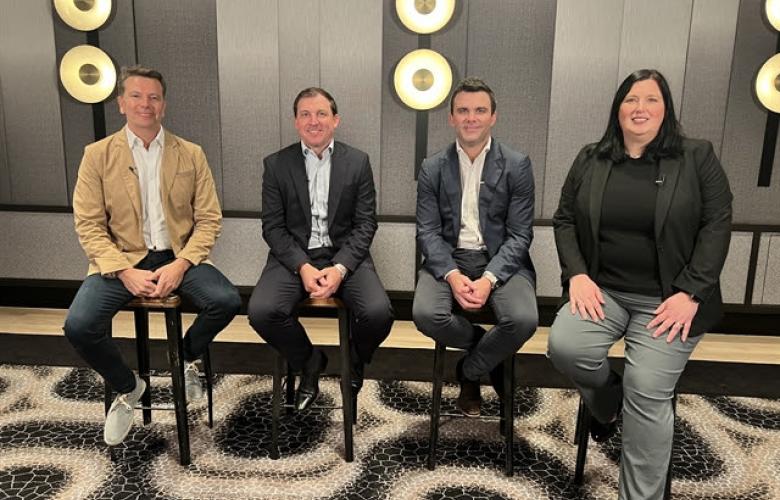Experts discuss nations office markets - RWC
Contact
Experts discuss nations office markets - RWC
Hundreds of people tuned in to August’s Between the Lines webinar which focussed on office markets around the country.
Hundreds of people tuned in to August’s Between the Lines webinar which focussed on office markets around the country.
Host Ray White head of research Vanessa Rader, was joined by office leasing experts Luke Pavlos, director of commercial services at RWC WA, Sean Hennessy, director of office leasing at RWC Queensland, and Jeremy Piggin, director at RWC Sydney Office Leasing.
The panel of experts looked at the recent results from the Property Council of Australia's office market report, unpacking current vacancies, take up, supply, and the future of Australian office markets in the post pandemic environment.
Ms Rader said Queensland and Western Australia had seen the best performing office markets thanks to migration and increased population during the pandemic.
She asked Mr Hennessy what had been happening in the Brisbane market.
“With the Olympics coming and everything positive that’s happening there, we’ve really seen a positive uptake in tenant moves,” Mr Hennessy said.
“What we’ve seen essentially is that flight to quality with people moving up to that prime grade stock. Secondary grade stock is getting a little bit left behind.
“We’re also seeing a lot of those fringe markets really come into their own. After covid now everything is starting to go back to normal, and we’re starting to see some businesses venture out from the CBD.
“Overall it’s been going strong and there’s been some really positive signs for us.”
Ms Rader said the Brisbane CBD was one of only two CBDs which saw a vacancy decline in the last year.
She said Western Australia’s office market was also doing quite well, despite the state not having the same work-from-home issues seen by the eastern states due to its strong border closures during covid.
“We’re travelling pretty well and weren’t affected too much by covid over that period. Borders shut and allowed us to get on with business in terms of the mining sector, with commodity prices some of the highest they’ve been in a long time,” Mr Pavlos said.
“That really helped to grow mining projects and infrastructure projects which has then filtered into the office markets as well, with companies taking up more space. That feeds into other areas as well such as legal, accounting, and engineering - it’s been really positive.
“We haven’t been affected too much by working from home, we have the highest occupancy rate in Australia.”
While Western Australia had seen strong demand from tenants in the mining sector, Mr Hennessy said Brisbane had seen any particular tenant types looking for office space, but instead a shift in the kind of space tenants were after.
“When they’re moving, tenants are almost trying to earn the right to ask staff back into the office, which means creating a good environment, getting the fit outs and moving away from that stereotypical office space,” Mr Hennessy said.
“They’re trying to create a reason for staff to want to come into the office.”
With the Sydney office market being heavily affected by covid lockdowns and working from home, Mr Piggin said businesses were definitely trying to create spaces which encourage staff to come back into the office.
“A lot of businesses are really struggling to work out their head count, like how many people will be coming in on how many days, and what type of building and fit out do we need to cater for those. And also what kind of culture they want to create to attract staff back to the office,” Mr Piggin said.
“Depending on the sector it does differ, legal and IT for example are completely different in their outlook. At the moment there’s a lot of sublease space on the market in the IT industry.
“A lot of those IT companies want to have space but they want to downsize. They often don’t need to find space straight away and can work from home or go into co-working flexible office arrangements for a few months while they work out their exact headcount and what kind of fit-out they need. There’s a lot of moving parts.
“It’s been a challenging year but there are transactions happening, it’s just a bit of a different landscape at the moment.”
Due to the uncertainty in the office space for a lot of businesses, Mr Piggin said he was noticing an increase in flexible working spaces.
“They’re trying to provide more flexibility in the fitout,” he said.
“We’re seeing more collaboration zones and more hot desking. We’re seeing more meeting spaces as well.
“A lot of companies are creating mandates where you don’t own a particular workstation, you just come in and put your stuff in a locker and share the space.
“So companies don’t need as big a footprint as they did in the past, but that’s depending on the sector again. Law firms seem to be a lot stricter on people coming back to work, but their fitouts are changing as well to become more of an open plan environment.”
Shorter-lease agreements were also a trend the experts were seeing across their respective markets.
“Small to medium size tenants are going for shorter lease agreements now because of the uncertainty of where they’re going to be, so those three-five year leases are becoming more common because of that,: Mr Hennessy said.
Mr Piggin said landlords were having to be more flexible with their lease agreements.
“We’re now sometimes seeing two-year terms,” he said.
“Incentives are huge compared to what we’ve seen historically.
“So a lot of owners are having to get creative in order to attract tenants back into the market and lease out space.
“There’s a lot of backfill space in the secondary market, big chunks are coming up now. So its a time now for owners to try and improve their amenity, refurbish, and make sure they have a product in the market that can attract new tenants moving forward.”








